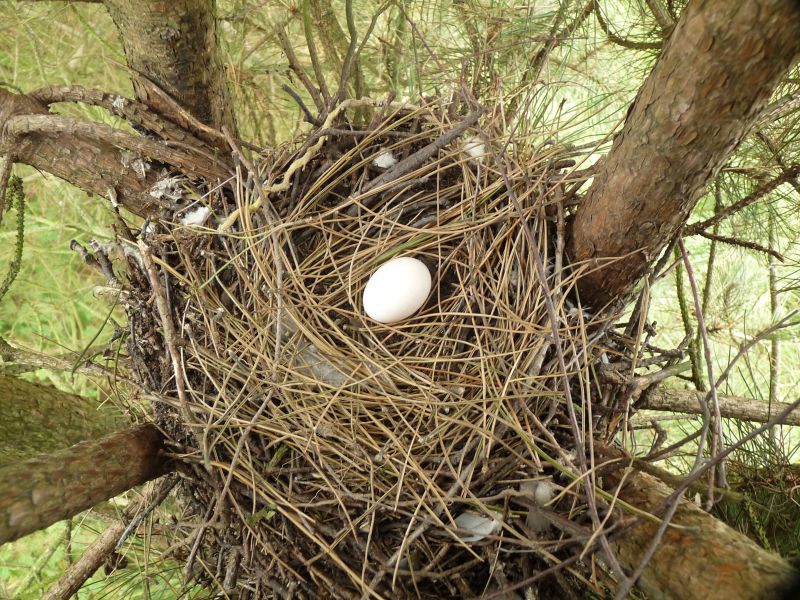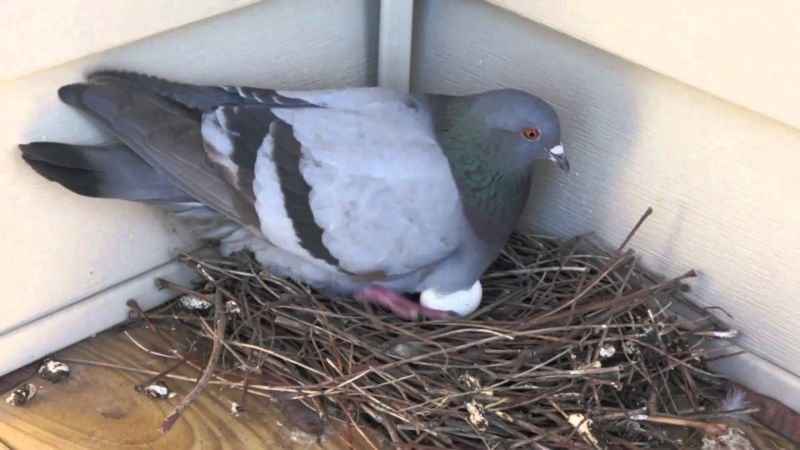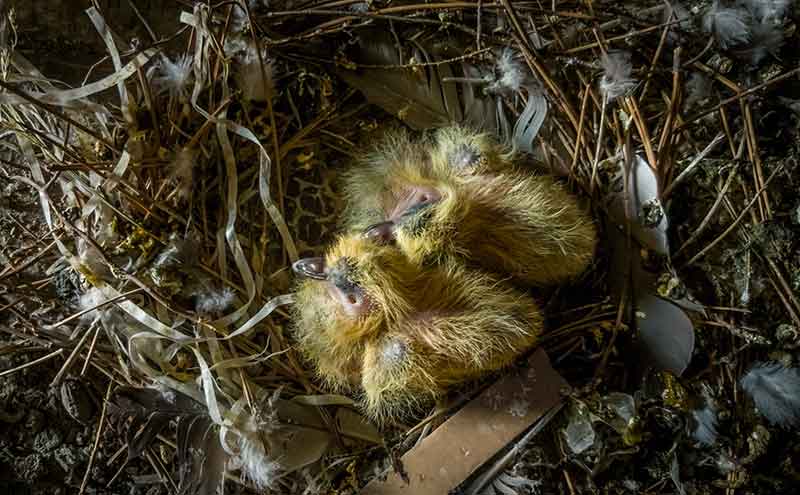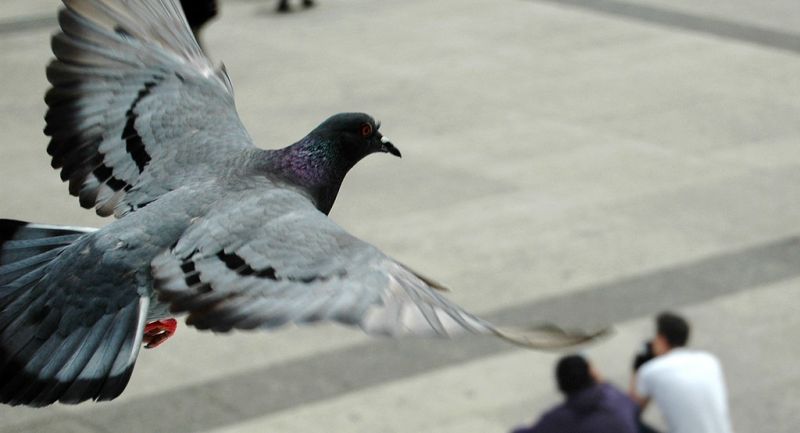Pigeons are those cute, plump little birds that seem to pop up everywhere. From the Rock Pigeon to the Mourning Dove, there are many different types of these birds roaming in the city and country. One unique habit of these birds is the way they nest. They have a unique way of building their nests, taking turns sitting on the eggs, and then taking care of their young in that nest. We have all you need to know about pigeon nesting habits.

Pigeon Nest Locations
The main requirement for a pigeon nesting site is that it is dry and protected on a flat surface. They usually like to nest in attics, on roofs, ledges, eaves, and under bridges. Their natural nesting site would be on a rocky cliff crevice or in a cave. This is why they typically nest on high, flat ledges.
Courting And The Nest
The nest isn’t a true home until a male pigeon finds his mate. The male starts to build the nest while calling out for a mate. He’ll sit on the nesting site until he attracts his lady. He will often strut around cooing at his favorite lady. If the female is interested, she will return the favor. The two will “kiss” by billing each other. After the male pigeon attracts his favorite female pigeon, he will start searching for nesting material. He does not want to waste any time. He will start to bring her one twig at a time. If the female pigeon doesn’t stay up to his pace, he will drive her into the nest and strike her with his wings. Finally, the female will take the twigs he has brought her, tucking them underneath her as the nest starts to build around her. Pigeons usually remain together for eternity. They usually mate in pairs. After they go through their dating stage and mate, it’s time to have squabs. If one of the pigeons passes away or is somehow separated, one will mate with another single bird. During the day, the male sits on the completed nest that usually contains one or two eggs. The female will take her turn overnight. Pigeons nest throughout the year. They might have 10 squabs each year.

The Look Of A Pigeon Nest
If you stumble upon a pigeon’s nest, it’s not a pretty sight. It looks like a mess of grass stems, pine needles, twigs, sticks, and other debris. It’s piled up with a small depression in the middle. A nest is used throughout the year, so it will start to accumulate more droppings and feathers. Many birds remove droppings from the nest, but pigeons do not. The droppings start to essentially glue together all of the nesting materials. After a brood is pushed out of the nest, the pair uses the same site for the next brood. They simply add new nesting material. These “new” nests may include mummies of pigeons that didn’t survive and unhatched eggs. A nest that is reused multiple years may grow up to eight inches tall and 20 inches wide. They may weigh almost five pounds.
Nest Eggs
The female usually lays about two eggs within the first few days of nesting. One unique thing about pigeons is that both the male and female will sit on the eggs to insulate them. Most of the time, the female will be in the nest from the middle of the afternoon to the middle of the morning. This will go on for about 18 days.
The young pigeons called “squabs” are born covered in yellow down. While the squabs are in the nest, they eat crop milk. Crop milk is thick regurgitated liquid that comes straight from the parents’ mouth. Squabs are fed this way for about ten days when they can start eating what the adult female and male pigeon eat. The squabs will double their size in about two days. This makes baby pigeons one of the fastest growing vertebrates. In two weeks, baby pigeons will get their flight feathers. They’re covered in feathers by their third week of life. Their tail will completely full of feathers by their 28th day of life. It’s now time to leave the nest. The time that a squab is in their nest is about 15 days longer than most backyard birds. Once the pigeon is gone, the female pigeon will begin laying new eggs almost every month.

Getting A Glimpse Of Squabs
Many people wonder why they never see baby pigeons. This is because baby pigeons love their nest. They hang out in their nest as their feathers grow in. Squabs are a tasty dinner, so it’s important they stay in their nest so they aren’t eaten. The baby pigeons will finally leave their nest when they are full grown. The short, fat pigeons that are usually seen on your lawn, woodpigeons, you’ll be able to identify a young pigeon because they don’t have a white flash on their neck until they’re adults. Getting a glimpse of these babies is tough because they’re well protected and don’t need to leave until it’s time.
Unique Eating In The Nest
If you are lucky enough to observe baby pigeons, you’ll notice their feeding cycle is unique to other birds. Besides eating their crop milk, they have other special patterns. Either the female or the male will feed the squabs. Once the parent lands near their nest, it seems to be a race as to which bird will be the first to insert their tiny beak to get that food. The parents stay dedicated to feeding their babies until they’re able to leave the nest. Every day, one or the other would arrive with food for the young birds.
NOTE: though tempting, if you stumble upon a pigeon nest, try to resist the urge to feed the squabs yourself. It’s important that they get fed by mom or dad. If you want to help out and do your part, the adult pigeons would probably love some pigeon seed.

Returning Home
Pigeons are loyal to their nests. As we mentioned before, they have numerous broods in one nest. These birds are known to return to whatever their home may be. Pigeons were used to carry messages are far back as 2500 BC, The ancient Greeks and Romans used them to carry messages, then Persia and Syria made a messaging service with pigeons. In the 19th century, pigeons carried messages for news agencies and financial institutions and news agencies in Europe and even providing an airmail service in New Zealand. The point is that pigeons are a bird that know how to take a message somewhere then return home. They can gather food all day, then return to their nest without any issues.
Pigeon Nests And You
Depending on where you live, you may want to help provide nests for the local pigeons (or alternatively if there are too many pigeons around already, possibly deter them from nesting in your area). Here are some tips:
Providing Nests
If you are in a place where you can provide a nest for pigeons, it’s important that each pair of birds gets at least two nests. This is because pigeons usually have a few broods of squads. They need two nests so they can adequately care for each brood of the baby pigeons or their eggs. Their nest should be build twelve inches square. You should always attach a three-inch long perch. They prefer tobacco stems, straw, or hay as the base of a constructed nest.
Deterring Nests
If you would rather your home not become a nest for these sweet squabs, you should keep things very clean. Pigeons like to build nests in a place of shelter. They don’t like a lot clutter or clamor. They usually make their nests when no one is using an areas. If you don’t want them on your patio, make sure to keep it swept. They love to pick up leftover debris to make nests.
Moving A Nest
It’s important to never move a pigeon’s nest. It might seem normal if you think they might be in danger, but a nest location is critical to their survival. Only licensed professionals can move a pigeon’s nest. Pigeons don’t have a sense of smell to find their new nesting location. If you move a nest, the parent may abandon their young. This is critical because squabs need parents, even after they have left the nest. The male and female pigeon will still show their young how to escape from predators, fly, and integrate with the flock. If you need to move a nest, it is best to wait a few months until the squabs are for sure out and about on their own. The parents will be forced to make a new nest elsewhere for their next brood.
Backyard Tips
You may spot a pigeon in your backyard. They are attracted to large, open areas where it is easy for them to find food places on the ground. The only issue with this is that ground food can attract rodents. It’s usually best to only feed pigeons when you see them in your yard. They enjoy peas, dried corn, or sorghum.
Final Words
A pigeon nest is a unique home that can house hundreds of birds over time. Each brood is full of new squabs hungry for their new life. If you get a chance to see a squab in their pigeon nest, take note of the excitement. The nest is an artistic place where parents can raise dozens of little squabs until they’re ready to bust into the world on their own.
Related
- Ever wondered what the best place to live is if you happen to be an avid birder? Check out our list in Best Places To Live For Birders. Maybe you’ll find your next ideal home spot!
- Now that you’ve seen what a pigeon nest looks like, how about a hawk’s nest? Check out Cooper’s Hawk Nesting Habits and learn a little more about Cooper’s hawk’s nests, as well as how they tend to their young.
I am an old person with a balcony and the pigeons do not leave me alone….PLEASE HELP ME GET RID OF THEM
Hey Carola,
Try reading this:
https://pmpest.co.uk/how-to-get-rid-of-pigeons/
There’s a few methods in there, they mention Falcony which is something I’d never heard of, crazy.
We have nesting pigeons in our tree for about the 3rd year running….they sit on our fence and then build the nest.
We feed them and they are very at ease in our garden, lovely to watch and have around.
They are currently sat on the next so we are eagerly awaiting some new arrivial very soon hopefully!!
I have messy courtyard I don’t use much in the winter months..i usually tidy it up about this time of year. Last week I was hanging some washing under the patio (i have wire chord strung from one side to the other) and it was nighttime. I habe a few desd branches that have ivy growing around them from the sidewalls….theres a few empty coconut fubre hanging baskets up from when my grandad lived here…anyways I knocked one of the hanging branches a bit while hanging laundry and two pigeons flew out from behind it into the night sky and thats when I looked over into the basket to see what they were doing and that i wasnt half asleep, and realised there were two eggs in there so the pigeons had made a nest there.
I actually feel quite flattered they wanted to nezt in my comfy overgrown but happy vibed courtyard….however I am worried about pigeon poop and getting sick?? ( I have an autoimmune disorder). I dont spend a heap of time out there, more in the peak of summer. Theres a mandarin tree in the garden and a bunch of other trees not under the undercover patio…
•Should I be worried about pigeon pooop? Its not like it will get on my clean laundry…maybe on the ground but more likely the nest…
•Can I give them bird seed or dry corn? If i leave it out on a tray near their nest?
•Will they attempt to use this nest again, can I move it slightly when the squabs leave the nest?
•Can I try befriend them or make them feel comfortable with me so they dont think i am a predator? It is a smallish court yard and theyve nested in a hanging basket to the sidewall thats right near where my twine chairs are…i wanna use my backyard but i dont want the pair to abandon their nest/eggs either…
•Will rats eat the eggs? Theres a swamp in my area and sometimes there are rats around here, I hear em in the roof from time to time/have seen a few scuttle along the neighbouring dividing fences.
Thanks!
I also have a bobtail lizard living in my front garden. Its been there for a few weeks. Had heaps of weeds but got rid of them today, they were getting long like jungle grass. Seems the lizard enjoyed the shelter and habitat under and around my huge hibiscus tree. I dont have any pets and I really want dog or cat or something to cuddle so I guess nature is giving me the next best thing and allowing me to facilitate wild animals thriving here 🤣🤣
Any tips. I did what I thought was the right thing, and saved a baby who’s nest had been destroyed by tradesmen. He now appears to have bonded with me, cooing and dancing and even trying to mate with me. He’s now making a nest under the eaves by my back door. Any advice to help him ‘move on’? I thought I’d be more mummy than girlfriend
Can anyone advise me. I have been enjoying the wonders of watching a rock dove couple nesting and raising babies for a couple of years. I sometimes give them a little food too. I have read and observed they are generally monogamous and that the young go off their own way after they grow up. What is odd that a third party has moved in to the nest with them. I don’t know if this is a grown-up youngster, or a friend, as i travelled abroad and have no idea where he came from. The third adult rock dove has been there and fully grown at least 5 months, looks like a male, due to very elaborate plumage, behaves like a young pigeon (meek-not aggressive) The male seems to be devoted to him. Is it possible that the parents would allow a grown up pigeon to stay with them permanently, or for a third party to move in with them. I am really curious.